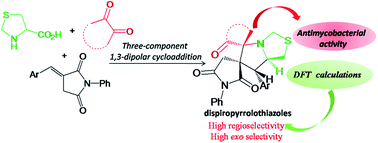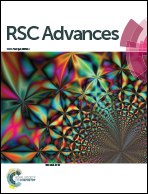Synthesis of novel dispiropyrrolothiazoles by three-component 1,3-dipolar cycloaddition and evaluation of their antimycobacterial activity†
Abstract
In an on-going effort to develop novel anti-tubercular agents, a series of original dispiropyrrolothiazole derivatives have been synthesized by three-component 1,3-dipolar cycloaddition of (E)-3-arylidene-1-phenyl-pyrrolidine-2,5-diones, 1,3-thiazolane-4-carboxylic acid and cyclic diketones. The stereochemistry of the spiranic adducts has been confirmed by an X-ray diffraction analysis. Theoretical calculations have been carried out using DFT approach at the B3LYP/6-31G(d,p) level allowing an explanation for the observed regio- and stereoselectivity. The newly synthesized compounds were screened in vitro against Mycobacterium tuberculosis H37Rv and the most active compounds were tested for cytotoxicity studies. Some compounds exhibited significant activity, in particular dispiropyrrolothiazole derivatives 15c and 15f emerged as the most promising antitubercular agents.


 Please wait while we load your content...
Please wait while we load your content...